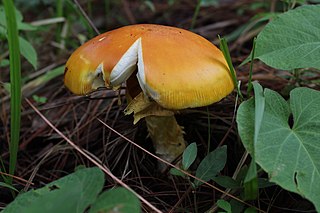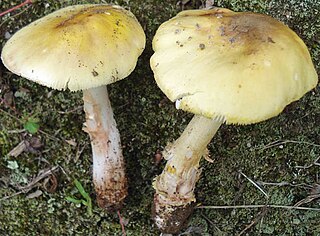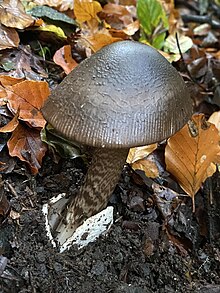Amanita altipes, also called the yellow long-stem amanita, is a species of agaric fungus found in coniferous woodlands in southwestern China.

Amanita brunnescens, also known as the brown American star-footed amanita or cleft-footed amanita is a native North American mushroom of the large genus Amanita. It differs from A. phalloides by its fragile volva and tendency to bruise brown.

Amanita persicina, commonly known as the peach-colored fly agaric, is a basidiomycete fungus of the genus Amanita with a peach-colored center. Until c. 2015, the fungus was believed to be a variety of A. muscaria.

Amanita australis is a species of fungus in the family Amanitaceae. It produces small- to medium-sized fruit bodies, with brown caps up to 9 centimetres in diameter covered with pyramidal warts. The gills on the underside of the cap are white, closely crowded together, and free from attachment to the stem. The stem, up to 9 cm long, has a ring and a bulbous base. The mushroom may be confused with another endemic New Zealand species, A. nothofagi, but can be distinguished by differences in microscopic characteristics.

Amanita nothofagi is a species of fungus in the family Amanitaceae. Endemic to New Zealand, the species was first described by mycologist Greta Stevenson in 1962. The fruit bodies have dark brown caps that are up to 13 cm (5.1 in) in diameter and covered with patches of soft greyish-brown scales or warts. The gills underneath the cap are crowded together, free from attachment to the stem, and white, becoming tinged with yellow in age. The stem of the mushroom is 4–14 cm (1.6–5.5 in) long by 0.5–2.5 cm (0.2–1.0 in) thick, and has a ring. The spore print is white, and individual spores are spherical to ellipsoid, measuring 7.5–9 by 7.5–9 micrometres. The mushroom may be confused with another New Zealand species, A. australis, but can be distinguished by certain characteristics. Amanita nothofagi is a mycorrhizal species, and grows in association with native New Zealand trees such as Southern Beech.

Amanita nehuta, also called Maori dust amanita, is a species of fungus in the family Amanitaceae.It has only a dark ring rather than a universal veil and white spores. Abundant in New Zealand, it can be found growing under Leptospermum and Nothofagus species.

Amanita crocea, the saffron ringless amanita, is a species of Amanita widely distributed in Europe. It is not recommended for consumption due to its similarity to poisonous species of the genus.

Amanita albocreata, also called the ringless panther or the ringless panther amanita, is a species of fungus in the family Amanitaceae. It was discovered in 1944, by William Murrill. It is commonly found in northeastern United States and southeastern Canada and elsewhere in North America. This species, that grows about 5 to 15 centimeters in length, is doubted to be fatally toxic. It normally grows between the rainy months of June and August.

Amanita parcivolvata also known as ringless false fly amanita, is a fungus that produces fruit bodies ranging from 3–12 centimetres in width and height.

Amanita basii is a mushroom of the family Amanitaceae.

Amanita umbrinolutea, also known as the umber-zoned ringless amanita, is a species of the genus Amanita.

Amanita flavorubens, also known as the yellow American blusher or the yellow American blushing amanita, is a species of the mushroom genus Amanita.

Amanita spreta or the hated amanita is an inedible species of the genus Amanita.

Amanita crenulata, also known as the poison champagne amanita, is a species of fungus that is very common in the Northeast United States.

Cortinarius diaphorus is a species of purple pouch fungus in the genus Cortinarius endemic to Aotearoa New Zealand.

Thaxterogaster austrovaginatus is a species of ectomycorrhizal fungus in the famlily Cortinariaceae.

Cortinarius violaceocystidiatus is a species of purple pouch fungus in the genus Cortinarius. It is endemic to Aotearoa New Zealand.

Pluteus microspermus is a saprotrophic, mushroom-like (agaricoid) fungi in the Section Pluteus. It is often confused with Pluteus concentricus, a species endemic to New Zealand because P. concentricus also has concentric ridges on its cap (pileus). P. microspermus and P. concentricus can be differentiated by microscopy as the spores are different sizes. P. concentricus also has rougher material on its stipe.

Tympanella galanthina, or cottonbud pouch, is a secotioid fungus in the monotypic genus Tympanella, a member of the Bolbitiaceae family. It is endemic to New Zealand.

Saproamanita inopinata, commonly called unexpected anamita, is a basidomycete fungus in the subgenus Saproamanita. This species was previously called Anamita inopinata, before being briefly renamed to Aspidella inopinata until it received its current name. The native range is currently unknown, with it currently being considered introduced into both New Zealand and England.




















